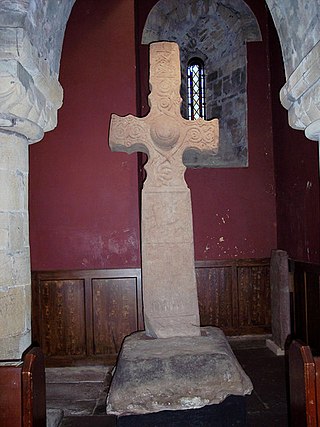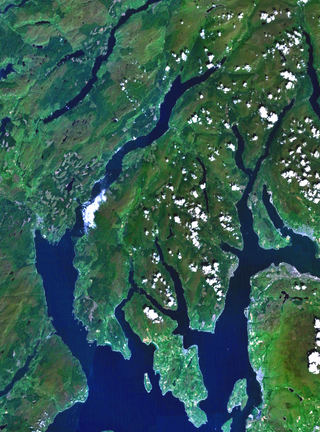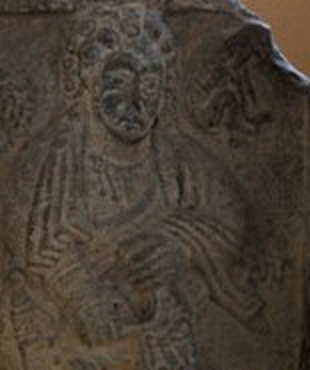Related Research Articles
Óengus mac Fergusa was king of the Picts from 820 until 834. In Scottish historiography, he is associated with the veneration of Saint Andrew, the patron saint of Scotland, although this has not been proven.

Causantín or Constantín mac Fergusa (789–820) was king of the Picts, in modern Scotland, from 789 until 820. He was until the Victorian era sometimes counted as Constantine I of Scotland; the title is now generally given to Causantín mac Cináeda. He is credited with having founded the church at Dunkeld which later received relics of St Columba from Iona.

Comgall mac Domangairt was king of Dál Riata in the early 6th century. He was the son of Domangart Réti and grandson of Fergus Mór. The Annals of Ulster report his death in 538, 542 and 545, the Annals of Tigernach in 537.

The Battle of Dun Nechtain or Battle of Nechtansmere was fought between the Picts, led by King Bridei Mac Bili, and the Northumbrians, led by King Ecgfrith, on 20 May 685.

Óengus son of Fergus was king of the Picts from 732 until his death in 761. His reign can be reconstructed in some detail from a variety of sources. The unprecedented territorial gains he made from coast to coast, and the legacy he left, mean Óengus can be considered the first king of what would become Scotland.

Bridei son of Maelchon was King of the Picts from 554 to 584. Sources are vague or contradictory regarding him, but it is believed that his court was near Loch Ness and that he may have been a Christian. Several contemporaries also claimed the title "King of the Picts". He died in the mid-580s, possibly in battle, and was succeeded by Gartnait son of Domelch.
Naiton son of Der-Ilei, also called Naiton son of Dargart, was king of the Picts between 706–724 and between 728–729. He succeeded his brother Bridei IV in 706. He is associated with significant religious reforms in Pictland. He abdicated in 724 in favour of his nephew and became a monk. In 728 and 729 he fought in a four-sided war for the Pictish throne.

Bridei son of Beli, died 692 was king of Fortriu and of the Picts from 671 until 692. His reign marks the start of the period known to historians as the Verturian hegemony, a turning point in the history of Scotland, when the uniting of Pictish provinces under the over-kingship of the kings of Fortriu saw the development of a strong Pictish state and identity encompassing most of the peoples north of the Forth.
Drest was king of the Picts from 724 until 726. He succeeded Nechtan mac Der-Ilei when the latter abdicated and entered a monastery in 724.
Bridei son of Der-Ilei was king of the Picts from 697 until 706. He became king when Taran was deposed in 697.
Nechtan grandson of Uerb, was king of the Picts from 595 to around 616, and may be the same person as the Neithon son of Guipno who ruled the kingdom of Altclut.
Gartnait, son of Domelch, was a king of the Picts from 584 to 595.

The origins of the Kingdom of Alba pertain to the origins of the Kingdom of Alba, or the Gaelic Kingdom of Scotland, either as a mythological event or a historical process, during the Early Middle Ages.
Talorg son of Uuid was a king of the Picts from 641 to 653.
Alpín was king of the Picts from 726–728, together with Drest VII. The Pictish Chronicle king lists give Alpín and Drest a five-year joint rule.
Dargart mac Finguine was a member of the Cenél Comgaill kindred, after which Cowal in Scotland is named. The only event directly connected with him in the Irish annals, based on a chronicle then being kept on Iona, is his death.
Der-Ilei is believed to have been a daughter, or less probably a sister, of Bridei map Beli, king of the Picts. There are no explicit mentions of Der-Ilei in the Irish annals or other sources, and her existence and parentage are thus based on the implication of the surviving records.
Talorcan son of Drestan was king of Atholl in modern-day Scotland.
Finguine Fota or Finguine son of Eochaid was king of Cowal in modern-day Scotland, and a member of the Gaelic Cenél Comgaill kindred.
References
- ↑ The four-year reign and the accession in 692 are chosen by Anderson (1973) , p. 175
- ↑ Anderson (1973) , p. 90
- ↑ Anderson (1973) , p. 248
- ↑ Anderson (1973) , p. 263
- ↑ Anderson (1973) , pp. 266, 272
- ↑ Anderson (1973) , p. 280
- ↑ Anderson (1973) , p. 297
- ↑ M.O. Anderson, List D; Skene, no. XXIII.
- ↑ It writes frater eius after Taran's listing; see M.O. Anderson, op. cit. p. 266.
- ↑ see Clancy (2004)
- ↑ Marjorie Anderson believes these lists to derive from a list kept at Abernethy; she and others believe these lists, marked by "un-gaelicized" name forms, are more reliable; see Anderson (1973) , pp. 77–102.
- ↑ Anderson (1973) , pp. 248, 263, 297
- ↑ Annals of Ulster, s.a. 693.
- ↑ Anderson (1990) , p. 201, note 1
- ↑ Annals of Ulster, s.a. 697; Annals of Tigernach , s.a. 697
- ↑ Anderson (1990) , p. 202, note 7
- ↑ Annals of Ulster, s.a. 699
- ↑ Anderson (1990) , p. 206, note 5
- ↑ the Annals of Tigernach used the Tarachin form in reporting Taran's deposition.
Sources
- Anderson, Alan Orr (1990). Early Sources of Scottish History AD 500 to 1286. Vol. 1. Reprinted, with corrections by Marjorie O. Anderson. Stamford: Paul Watkins. ISBN 1-871615-03-8.
- Anderson, Marjorie Ogilvie (1973). Kings and Kingship in Early Scotland. Edinburgh: Scottish Academic Press.
- Clancy, Thomas Owen (2004). "Philosopher-King: Nechtan mac Der-Ilei" (PDF). Scottish Historical Review . 83 (2): 125–149. doi:10.3366/shr.2004.83.2.125.